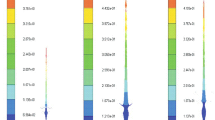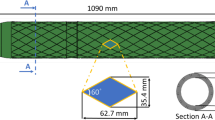Abstract
Amongst hundreds of different projectiles for air guns available on the market, hollow-point air gun pellets are of special interest. These pellets are characterized by a tip or a hollowed-out shape in their tip which, when fired, makes the projectiles expand to an increased diameter upon entering the target medium. This results in an increase in release of energy which, in turn, has the potential to cause more serious injuries than non-hollow-point projectiles. To the best of the authors’ knowledge, reliable data on the terminal ballistic features of hollow-point air gun projectiles compared to standard diabolo pellets have not yet been published in the forensic literature. The terminal ballistic performance (energy-dependent expansion and penetration) of four different types of .177 caliber hollow-point pellets discharged at kinetic energy levels from approximately 3 J up to 30 J into water, ordnance gelatin, and ordnance gelatin covered with natural chamois as a skin simulant was the subject of this investigation. Energy-dependent expansion of the tested hollow-point pellets was observed after being shot into all investigated target media. While some hollow-point pellets require a minimum kinetic energy of approximately 10 J for sufficient expansion, there are also hollow-point pellets which expand at kinetic energy levels of less than 5 J. The ratio of expansion (RE, calculated by the cross-sectional area (A) after impact divided by the cross-sectional area (A 0) of the undeformed pellet) of hollow-point air gun pellets reached values up of to 2.2. The extent of expansion relates to the kinetic energy of the projectile with a peak for pellet expansion at the 15 to 20 J range. To conclude, this work demonstrates that the hollow-point principle, i.e., the design-related enlargement of the projectiles’ frontal area upon impact into a medium, does work in air guns as claimed by the manufacturers.





Similar content being viewed by others
References
Brukner B (2011) Die Luftpistole. dwj-Verlags GmbH, Blaufelden
Wolff F, Laufer M (1965) Tödliche Kopfschußverletzung durch Luftgewehr. Arch Kriminol 137:78–83
Dittmann W (1986) Gehirnschußverletzungen durch Luftdruckwaffen. Z Rechtsmed 96:119–131
Allareddy V, Nalliah RP, Rampa S, Kim MK, Allareddy V (2012) Firearm related injuries amongst children: estimates from the nationwide emergency department sample. Injury 43:2051–2054
Bruce-Chwatt RM (2010) Air gun wounding and current UK laws controlling air weapons. J Forensic Legal Med 17:123–126
Monticelli F, Seidl S, Betz P (2002) Air rifle injury with an entrance through the nose: a case report and review of the literature. Int J Legal Med 116:292–294
Missliwetz J (1987) Zur Grenzgeschwindigkeit bei der Haut. Beitr Gerichtl Med 65:411–432
Frank M, Schönekeß HC, Grossjohann R, Ekkernkamp A, Bockholdt B (2014) Der „Huckepack“-Schuss: ballistische Parameter doppelt geladener Luftgewehr-Projektile. Arch Kriminol 233:123–129
Frank M, Schönekeß H, Herbst J, Staats HG, Ekkernkamp A, Nguyen TT, Bockholdt B (2014) Subcaliber discarding sabot airgun projectiles. Int J Legal Med 128:303–308
Frank M, Schönekeß H, Jäger F, Herbst J, Ekkernkamp A, Nguyen TT, Bockholdt B (2013) Ballistic parameters of .177 (4.5 mm) caliber plastic-sleeved composite projectiles compared to conventional lead pellets. Int J Legal Med 127:1125–1130
Kneubuehl BP (2013) Geschosse, Gesamtausgabe. Ballistik, Messtechnik, Wirksamkeit, Treffsicherheit. Stocker-Schmid, Dietikon
Vereinigung der Prüfstellen für angriffshemmende Materialien und Konstruktionen (VPAM) (2012) ARG 2012 Prüfrichtlinie „Materialien und Konstruktionen zur Vermeidung von ab- und rückprallenden Geschossen“. http://www.vpam.eu/fileadmin/Pruefrichtlinien_AKTUELL/ARCHIV/7_ARG/2012-05-23_ARG2012.pdf. Accessed 18 August 2016
Fackler ML (1987) Ordnance gelatin for ballistic studies. AFTE Journal 19:403–405
Kneubuehl BP, Coupland RM, Rothschild MA, Thali MJ (2011) Wound ballistics, basics and applications. Springer, Berlin Heidelberg
Haag LC (1989) Ballistic gelatin: controlling variances in preparation and a suggested method for the calibration of gelatin blocks. AFTE Journal 21:483–489
Bundeskriminalamt (BKA) (2014) Herstellung von Beschussgelatine (AA-21005-04). Bundeskriminalamt (BKA), Wiesbaden
North Atlantic Treaty Organization (NATO) (2013) NATO Standard AEP-94 skin penetration assessment of non-lethal projectiles, Edition A, Version 1
Kneubuehl BP, Glardon MJ (2010) Polizeigeschosse und ihre Deformation. Rechtsmedizin 20:80–84
Wightman G, Wark K, Thomson J (2015) The interaction between clothing and air weapon pellets. Forensic Sci Int 246:6–16
Venneman B, Dautel F, Braunwarth R, Strassburger E, Hunzinger M, Pollak S, Perdekamp MG (2008) Textile fibres along the bullet path—experimental study on a skin-gelatine composite model. Int J Legal Med 122:213–218
Author information
Authors and Affiliations
Corresponding author
Electronic supplementary material
Online Resource 1
(PDF 77 kb)
Online Resource 2
(PDF 75 kb)
Online Resource 3
(PDF 558 kb)
Online Resource 4
(PDF 564 kb)
Online Resource 5
(PDF 564 kb)
Online Resource 6
(PDF 558 kb)
Online Resource 7
(PDF 47 kb)
Online Resource 8
(PDF 50 kb)
Online Resource 9
(PDF 47 kb)
Online Resource 10
(PDF 21 kb)
Online Resource 11
(PDF 47 kb)
Online Resource 12
(PDF 1286 kb)
Rights and permissions
About this article
Cite this article
Werner, R., Schultz, B., Bockholdt, B. et al. Energy-dependent expansion of .177 caliber hollow-point air gun projectiles. Int J Legal Med 131, 685–690 (2017). https://doi.org/10.1007/s00414-016-1528-8
Received:
Accepted:
Published:
Issue Date:
DOI: https://doi.org/10.1007/s00414-016-1528-8




